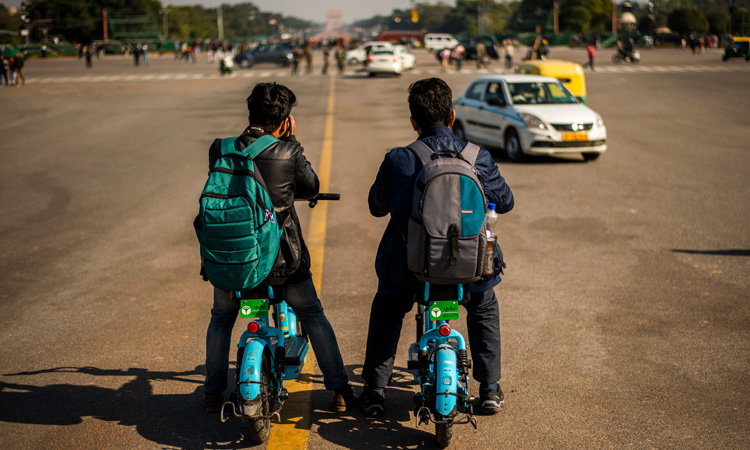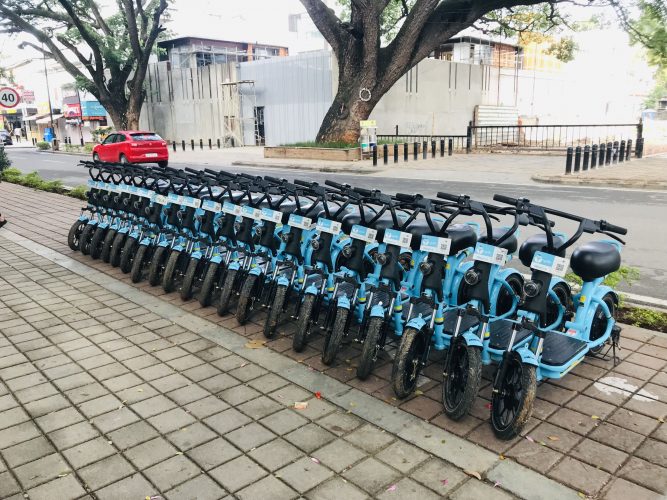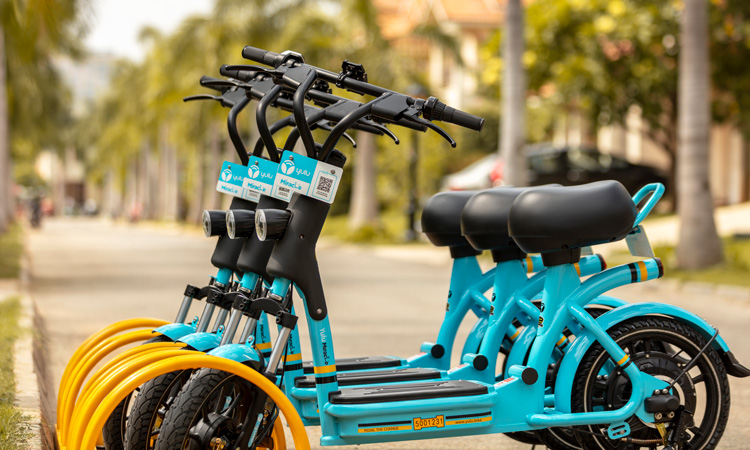Micromobility – the emerging growth driver for India during COVID-19
- Like
- Digg
- Del
- Tumblr
- VKontakte
- Buffer
- Love This
- Odnoklassniki
- Meneame
- Blogger
- Amazon
- Yahoo Mail
- Gmail
- AOL
- Newsvine
- HackerNews
- Evernote
- MySpace
- Mail.ru
- Viadeo
- Line
- Comments
- Yummly
- SMS
- Viber
- Telegram
- Subscribe
- Skype
- Facebook Messenger
- Kakao
- LiveJournal
- Yammer
- Edgar
- Fintel
- Mix
- Instapaper
- Copy Link
Posted: 9 July 2020 | Amit Gupta - Yulu | No comments yet
Amit Gupta, Co-Founder and CEO of Indian micromobility firm Yulu, explores the impact that COVID-19 has had on public transit and mobility in India and suggests why micromobility offers a solution.


Learning the new
In the last few months, many new words and phrases have insidiously made their way into our collective vocabulary, including mine. Earlier, “lockdown” was something that only happened in factories. “Furlough” and “pandemic” were alien terms. “Social distancing” last year would be considered downright rude.
Besides re-learning how to wash our hands, we have also learned extreme caution. The rapid spread of the contagion has necessitated social distancing. The extended lockdown of over two months has embedded the need to insulate ourselves, deep within our psyche. It has caused the dilemma, do we accept the lockdown or prepare for the new post-pandemic world?
Are we getting back on track?
As India prepares to go back to work post-lockdown, a simple question confronts most of us: “Just how do we go back?” Mobility has emerged as a massive challenge after the lockdown. Our public transit systems, especially in metro cities such as Mumbai and Delhi, are far from geared up for the needs of a teeming population in these testing times.
As people increasingly lose faith in public transit systems, there is a pressing need for a solution
The virus is still very much around. We still need to flatten the curve and avoid another peak. Are there sufficient local trains, metro trains, and public transport buses to ensure social distancing? Are they safe and sanitised every few hours? Unfortunately, no.
Public confidence in public transport declining
With the lockdown easing out, mobility has become a challenge, especially in large cities. Hundreds of thousands (lakhs) of people who would earlier travel in trains bursting at the seams, see the virus as a far greater threat today. Crowds, reduced frequency, and other problems plague our public transit systems. Mission Begin Again needs a substantial impetus to make India begin again.
Challenges of public transport systems
Before the lockdown, India’s public transport system ferried lakhs of passengers to their destination every day. Today, with the additional challenge of COVID-19 taking centre stage, the already strained, overburdened Indian public transport system seems to be collapsing under the pressure. The carefree passengers are now in fear of boarding it again.The need for social distancing: Before the lockdown, I remember reading reports about commuters falling off local trains in Mumbai due to overcrowding, every other dayLet’s take a look at some of the challenges in the new scenario:
- Delhi metro trains transported lakhs of passengers every day. It seems unrealistic to expect that the same train passengers will now have the luxury of a dedicated seat to themselves
- The need for increased frequency: Due to social distancing, a shared vehicle can accommodate fewer passengers, which means that the frequency needs to be improved. Operating at maximum frequency before the lockdown, public transport failed to prevent overcrowding then. Therefore, increasing the frequency is hardly an option now
- The need for frequent sanitisation: Professional sanitisation of vehicles has become a necessity to prevent the spread of the coronavirus. Due to the long distances they cover, it may be impractical to halt and sanitise local buses and trains every two hours, thereby increasing the risk of more coronavirus outbreaks.
Almost half of India’s workforce has started going back to the workplace. While private vehicles are the most preferred mode of transport during COVID-19, vehicle ownership in India is relatively low at just 18 per cent according to one estimate.1
As people increasingly lose faith in public transit systems, there is a pressing need for a solution.
Micromobility: Driving change, driving India


Micromobility is the clear answer. I believe it has vast, untapped potential for driving India on the road to recovery from COVID-19. Encouraging cycles, e-bikes, walking, and other solo commute options could help India battle the contagion on multiple fronts.
I now share a few pointers on why micromobility can lead to India’s recovery from COVID-19, especially in the face of decreasing confidence in public transit systems.
- Solo commute for social distancing
A recent survey by Yulu reveals that 70 per cent commuters regard “safety from the virus” as the critical factor determining their mode of transport. 67.8 per cent commuters have said that they would not sit next to a commuter at any cost when using shared mobility.
Micromobility services such as Yulu address these concerns by offering commuters the safety of single-passenger vehicles with minimal human interaction and natural social distancing. Innovations such as Yulu’s long-term rental plan ensure that a commuter does not have to share the vehicle for an extended time.
- Precautions to prevent the spread of infections
The COVID-19 crisis is far from over in India. According to some estimates, intermittent social distancing may be needed until the Year 2022. In short, we need to learn to live with the infection and safeguard ourselves against it at all times, even when we commute.
Our public transit systems, especially in metro cities such as Mumbai and Delhi, are far from geared up for the needs of a teeming population in these testing times.
Micromobility can provide a long-term solution by thinking smart. For instance, Yulu’s Hub-To-Hub Model ensures parking of bikes at designated spots; so only those needing a bike come near a YuluZone. This minimises random human interaction with the bikes. Moreover, thanks to Technology-Assisted Sanitization, Last-Sanitized Time Stamp, and the Bring Your Own Helmet (BYOH) policy, commuters are assured of maximum safety.
- Ability to service a vast population
Micromobility can address the transportation needs of India’s teeming population. Car ownership is abysmally low in India and is unlikely to pick up for a while, as consumers avoid discretionary spending due to the economic crisis. Public transit systems are perceived as unsafe in the COVID-19 context. The solo commute is clearly the way forward.
As hygiene and sanitisation become top priorities, the dependence on single-passenger vehicles, and consequently micromobility, is expected to grow. I believe it is only a matter of time before you see a Yulu bike at every corner. Micromobility will become the new mobility normal.
- Ideal for shorter distances
With remote working, distance education, telehealth services, and virtual events, the pandemic have changed how we live, learn, and experience. Overall, the need for long commutes has reduced. According to a study, 65 per cent of the journeys by Indian households are of distances up to 10 km.
Micromobility is ideal for seamless connectivity across short distances. Using a micromobility vehicle booked through the Yulu app, a person can enjoy first and last-mile connectivity that’s sustainable, affordable, and safe.
- Helps avoid crowded areas:
Travelling through crowded areas compromises social distancing norms, putting commuters at high risk of contracting the coronavirus. Shared transport systems usually have fixed routes that may include overcrowded areas.
Micromobility gives commuters the flexibility of a self-owned vehicle. So, commuters riding a single-passenger vehicle can determine their own travel routes and avoid crowded areas. Thus, micromobility solutions help curb the spread of infection, supporting India’s battle against the coronavirus.
- Supporting our frontline COVID-19 warriors
Public transport, being shared in nature, poses a high risk of contracting the coronavirus currently. Medical professionals, banking staff, essential goods delivery persons, and other frontline warriors are exposed to the risk each day.
Micromobility is a viable option for protecting the health of those who are sacrificing their family life and safety for the nation. I’m pleased to say that in April 2020, during the lockdown, Yulu offered its vehicles to medical professionals and banking staff. We also tied up with some grocery stores. In fact, many of our maintenance staff members served as delivery agents for various companies. Where there’s a challenge, micromobility shows the way.
- The impetus for economic revival
Coronavirus has struck not only the health and life of India’s people but also the economy. The lockdown has resulted in business shutdowns, layoffs, wage cuts and more. Even after the lockdown, it will be a while before people start visiting their favorite restaurants and malls or go for a movie.
Micromobility will become the new mobility normal
By enabling safe journeys and building confidence in commuters, micromobility can accelerate the return to normalcy. As more businesses reopen and more people return to workplaces, the economy gets into revival mode.
- The plan for a resilient nation


Micromobility could provide a viable, safe, and affordable transport option for the masses. Even after the COVID-19 crisis, micromobility could help ensure that challenges such as storms and air pollution do not disrupt the nation. We need to keep the country moving, and micromobility has the potential to do just that.
The future of micromobility in India
I firmly believe that given a viable alternative, commuters would avoid public transport due to the coronavirus risk. Micromobility is the emerging solution with benefits that cannot be ignored any longer. It can help tackle India’s economic crisis and the health crisis in the post lockdown period and beyond.
As hygiene and sanitisation become top priorities, the dependence on single-passenger vehicles, and consequently micromobility, is expected to grow.
However, for micromobility to take off in India, and drive the nation to recovery from COVID-19, some changes are needed. First, strategic investments in infrastructure such as pedestrian walkways and dedicated cycling tracks need to be made. Second, active government support through incentives and initiatives to promote private micromobility players such as Yulu is the need of the hour. Third, a complete shift in mindset needs to be encouraged and enabled through sustained communication and marketing efforts.
In conclusion, with the joint participation of all stakeholders, micromobility has immense potential to accelerate India’s recovery from the COVID-19 crisis and drive the nation – and the world – forward.
Reference
Biography
Amit co-founded InMobi, India’s first profitable internet unicorn. Prior to starting Yulu, Amit built a new business unit for InMobi that created massive value for Telecom Operators and Smartphone manufacturers. Amit played an instrumental role in building InMobi’s revenue engine and its expansion in 15+ countries.
Amit is also an active angel investor and has invested in multiple startups across India and the U.S. Amit graduated from IIT Kanpur and received the prestigious Distinguished Alumni Award from the institution.
Related topics
Air Quality, COVID-19, Mobility Services, Public Transport, Sustainable Urban Transport
Related cities
India
Related organisations
Yulu








